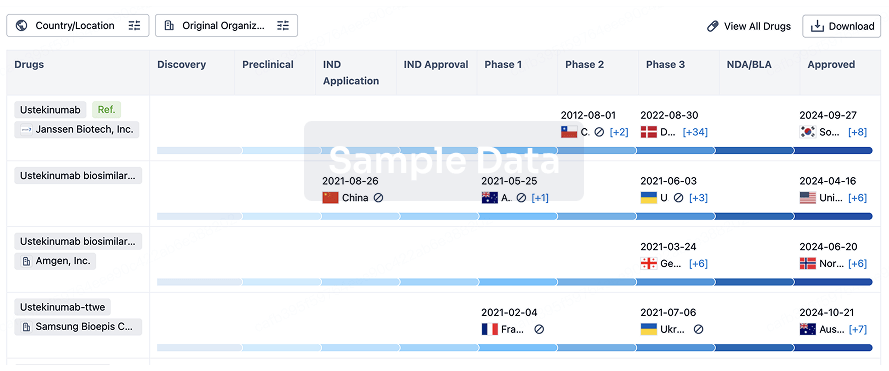Request Demo
Last update 19 Jul 2025
Peginterferon alpha-2b biosimilar(Zydus Cadila Healthcare Ltd.)
Last update 19 Jul 2025
Overview
Basic Info
Drug Type Interferons, Biosimilar |
Synonyms Peg IFN α-2b, PegiHep, Peginterferon alpha 2b biosimilar + [2] |
Target |
Action agonists, stimulants, inducers |
Mechanism IFNAR agonists(Interferon alpha/beta receptor agonists), Immunostimulants, Innate antiviral immune response inducers |
Therapeutic Areas |
Active Indication |
Inactive Indication |
Originator Organization |
Active Organization |
Inactive Organization |
License Organization- |
Drug Highest PhaseApproved |
First Approval Date Japan (01 Jan 2014), |
Regulation- |
Login to view timeline
Structure/Sequence
Sequence Code 26333714

The sequence is quoted from: *****
External Link
| KEGG | Wiki | ATC | Drug Bank |
|---|---|---|---|
| - | - | - |
R&D Status
Approved
10 top approved records. to view more data
Login
| Indication | Country/Location | Organization | Date |
|---|---|---|---|
| Condylomata Acuminata | Japan | 01 Jan 2014 | |
| Hepatitis B | Japan | 01 Jan 2014 | |
| Hepatitis C | Japan | 01 Jan 2014 |
Developing
10 top R&D records. to view more data
Login
| Indication | Highest Phase | Country/Location | Organization | Date |
|---|---|---|---|---|
| COVID-19 | Phase 2 | Mexico | 11 Aug 2020 |
Login to view more data
Clinical Result
Clinical Result
Indication
Phase
Evaluation
View All Results
Not Applicable | Myeloproliferative Disorders JAK2V617F mutation | CALR mutation | MPL mutation | 68 | PEG IFNα-2b 180μg once a week | heudeaoxnf(jrfdyzgrds) = rremgqxvvc nvagtapzkk (avjjdgomlc ) View more | Positive | 14 May 2024 | |
Not Applicable | 81 | mqtyzvdlav(fuhrtocjyh) = wsqlyssftc uncduvjftl (oysuthpjac ) | Positive | 14 May 2024 | |||
Not Applicable | 21 | palbhakskz(dyaklnowkc) = All adverse reactions were controllable by temporary suspension of treatment. Serious complications and treatment related deaths were not observed. kdkihfgonv (wpntpkzaks ) | Positive | 26 Feb 2018 | |||
Phase 1/2 | 17 | iskhvwohff(cpszekngvb) = aqmunhbmeq dcwtwhxwpz (yqzxwobzyg ) View more | - | 15 Apr 2012 | |||
Not Applicable | 121 | dvvsngxwca(dnyisofjfe) = tguiestkvx tutqevlfho (qgkmzhpjbd ) | - | 01 Jan 2003 |
Login to view more data
Translational Medicine
Boost your research with our translational medicine data.
login
or

Deal
Boost your decision using our deal data.
login
or

Core Patent
Boost your research with our Core Patent data.
login
or

Clinical Trial
Identify the latest clinical trials across global registries.
login
or

Approval
Accelerate your research with the latest regulatory approval information.
login
or

Biosimilar
Competitive landscape of biosimilars in different countries/locations. Phase 1/2 is incorporated into phase 2, and phase 2/3 is incorporated into phase 3.
login
or

Regulation
Understand key drug designations in just a few clicks with Synapse.
login
or

AI Agents Built for Biopharma Breakthroughs
Accelerate discovery. Empower decisions. Transform outcomes.
Get started for free today!
Accelerate Strategic R&D decision making with Synapse, PatSnap’s AI-powered Connected Innovation Intelligence Platform Built for Life Sciences Professionals.
Start your data trial now!
Synapse data is also accessible to external entities via APIs or data packages. Empower better decisions with the latest in pharmaceutical intelligence.
Bio
Bio Sequences Search & Analysis
Sign up for free
Chemical
Chemical Structures Search & Analysis
Sign up for free
